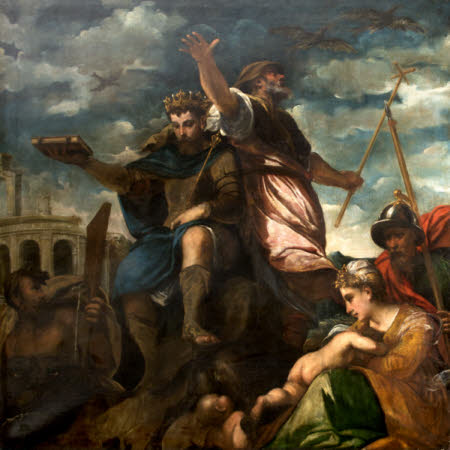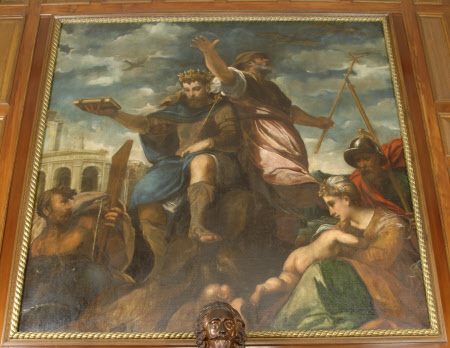An Allegory of Prophecy (King Numa and Augurs)
attributed to Antonio Palma (Venice c.1515 - before 1585)
Category
Art / Oil paintings
Date
circa 1575 - 1600
Materials
Oil on canvas
Measurements
2083 x 2083 mm (82 x 82 in)
Place of origin
Venice
Order this imageCollection
Kingston Lacy Estate, Dorset
NT 1257078
Caption
The message of the picture was once identified by an old Latin inscription translated as: The wise man seeks out the wisdom of the Ancients and has leisure for the prophets). Here the wisdom of the Ancients appears to be represented by the philosopher-king Numa (although given a contemporary dress with a fleu-de-lys crown, possibly emblematic of Henri III, who returned via Venice from the throne of Poland to that of France in 1574) who is presiding over the Augurs foretelling the future from the flight of birds. Numa Pompilius was the legendary second king of Rome, successor to Romulus, reigning 715-673 BC. He was credited with the foundation of the Roman religious system and the reform of the Roman calendar, inspired, it was said, with wise advice from his lover, the water-nymph Egeria. The painting was acquired, with Philosophers Disputing, both then attributed to ‘Bonifacio’ by William Bankes (1786–1855) in 1849, off the ceiling of the Palazzo Capello a San Felice in Venice and intended for the ceiling of the Library of Kingston Lacy. It is now attributed to Antonio Negeti Palma, pupil of Bonifazio de’Pitati and father of Palma Giovane.
Summary
Oil painting on canvas, An Allegory of Prophecy (King Numa and Augurs), attributed to Antonio Palma (c.1515 - before 1585), circa 1575/1600. One of two pictures then attributed to ‘Bonifacio’, acquired by William John Bankes (1786-1855) in 1849 off the ceiling of the Palazzo Capello a San Felice in Venice and intended for the ceiling of the Library. Its message was identified by an old inscription as Sapientiam antiquorum exquivet sapiens et in prophetis vacbit [The wise man seeks out the wisdom of the Ancients, and has leisure for the prophets]. Here the wisdom of the Ancients appears to be exemplified by the philosopher-king Numa (? here given a fleurdelysé crown, possibly emblematic of Henri III, who returned via Venice from the throne of Poland to that of France in 1574) presiding over the Augurs foretelling the future from the flight of birds. Numa Pompilius was the legendary second king of Rome, successor to Romulus. Numa traditionally ruled 715-673 BC; a long reign of peace. He was credited with the foundation of the Roman religious system and the reform of the Roman calendar, inspired, it was said, with wise advice from his lover, the water-nymph Egeria.
Provenance
Acquired by William John Bankes (with NT 1257244) from the Palazzo Capello a San Felice, Venice, in 1849 as 'Bonifac[z]io and intended for the ceiling of the Library at Kingston Lacy with its pair and the Tintoretto 'Apollo''; bequeathed by Ralph Bankes, 1981
Credit line
Kingston Lacy, The Bankes Collection (National Trust)
Makers and roles
attributed to Antonio Palma (Venice c.1515 - before 1585), artist previously catalogued as attributed to Jacopo Palma il Giovane (Venice c.1548 – Venice 1628), artist

